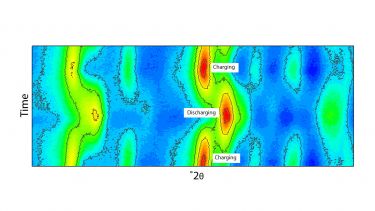Bought with a grant from the Henry Royce Institute, a state-of-the-art X-ray diffractometer (XRD) is being used to take measurements from energy storage materials in situ and during operation, addressing research questions that would otherwise be impossible to observe. Hosted at the University of Sheffield, Malvern Panalytical’s Empyrean is an industry-leading instrument fitted with hard X-ray sources, and there are only a handful in the UK. Easy access to the Empyrean is revolutionising the research being undertaken on the Faraday grants, and facilitating the UK’s commitment to cleaner, greener energy solutions.
The FutureCat project - led by Sheffield’s Professor Serena Corr and involving researchers from multiple disciplines across four other UK universities and partners in industry – aims to increase the range and acceleration of electric vehicles. Taking a co-ordinated approach to cathode chemistry design, development and discovery, they plan to deliver cathodes that hold more charge, are better suited to withstand prolonged cycling and promote ion mobility. Improved understanding of the atomic-level changes that occur during electrochemical cycling, enabled by the Empyrean, will be crucial in delivering on these challenges.
Sheffield engineers will collaborate on a University of Oxford-led project, Nextrode, to revolutionise the way electrodes for lithium-ion batteries are manufactured. This project aims to usher in a new generation of smart, high performance electrodes, which can also boost the range and performance of electric vehicles.
Researchers from the University of Sheffield are also partners in a project led by the University of St Andrews, Nexgenna, which will accelerate the development of sodium-ion battery technology. The project aims to put on the path to commercialisation a safe sodium-ion battery with high performance, low cost and a long life cycle, which could be used for static energy storage applications and low cost vehicles.
Dr. Nik Reeves-McLaren, an investigator on the Nexgenna project and Director of the XRD Research Facility at the University of Sheffield said, “The processes that occur when we remove large Na+ ions from sodium-ion battery electrode materials tend to be more complex and occur over a greater number of voltage steps, than in their lithium-based cousins. This isn’t ideal for applications, and tends to have been poorly understood. The Empyrean opens a new window on these important processes, and will allow us to much more rapidly optimise the performance of the next generation of cathode and anode materials for sodium-ion applications.”
Dr. Corinne Howse, Henry Royce Institute project manager, says,
The way that the Royce equipment is contributing to the Faraday Institute’s research projects is an ideal example of the Henry Royce Institute in action: it’s facilitating policy-led academic research with transformative industrial applications.”
Dr Corinne Howse
Henry Royce Institute Project Manager
All instruments and equipment funded by the Henry Royce Institute are available to academic and industry from across the UK. To find out more about the facilities, or to consult with a technical expert, contact Royce@Sheffield.ac.uk.


